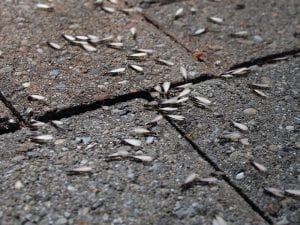How Rain Affects Termite Activity
If you’ve dealt with termites before, you may have noticed a seeming connection between rain and termite activity. Is there a real connection here? Let’s get to the bottom of whether rain affects termite activity and determine whether you need an exterminator to apply termite control to your property.
The Termite and Moisture
As we’ve seen previously, termites love moisture. All varieties need access to water to thrive and multiply. All termites receive some moisture from what they eat. And what they eat is wood. Most varieties need more moisture than this, though. Some varieties, like subterranean termites, can’t survive in the open air for more than a few minutes. If left exposed to sunlight, these termites desiccate and die.
One of the best termite prevention tools is simply preventing the conditions that termites are looking for. Seal the leaks that are causing wood in your structure to become damp. Replace decaying wood wherever you find it in your home or building. Lastly, ensure that no wood products extend below the soil line.
Termites and Rain
If termites love moisture, it stands to reason they are pretty big fans of rain, too. It’s true: they love the rain for at least two reasons. It improves their habitat and allows them to swarm.
Rain Improves Termite Habitats
First, termites love the rain because it usually improves their living situation. Subterranean termites benefit from added soil moisture, and many varieties indirectly benefit from additional soggy wood caused by leaks and standing water.

Rain Seems to Trigger Swarms
Second, rain causes well-established termite colonies to swarm, or at least it seems that way. The swarming may have more to do with warmth and humidity than with rain; regardless, the activity does often occur following rain. Flying termites, also called ‘swarmers’ or alates, will often emerge after rain from wherever they’ve been living. They start flying, often in large numbers. It can look like a large cloud or swarm of flying insects, hence the terminology.
This behavior is confusing to many people when they first encounter it, because the termites they see (if they’ve seen any) are usually wingless. Some people are tempted to dismiss the strange phenomenon as not being termite-related. This is, of course, a mistake.
The Purpose of Termite Swarming
The termites that swarm aren’t looking to eat quite yet. They’re looking to mate and to establish new colonies. Many of them die before they can accomplish their goals, but the few that do survive and establish new colonies can cause serious damage where they take up residence.
What to Do If You See Swarmers
If you see a few swarmers near or inside your house, you likely don’t have anything to worry about. They are probably swarming from a nearby property. Most will die, and you can help this along by killing the ones you see. Still, it’s a good idea to be on the lookout for signs of a termite colony over the next several months.
If it appears that the swarms are emerging from your property, that’s another story. The ones that you see won’t damage your home. Their goal is to fly away and mate. But the fact that they are emerging from your property strongly suggests you have an infestation.
If you’re worried that you may have an infestation, call us today. We want to be trusted exterminator, ready to help with termite control and other pest control needs. We have been serving the area since 1988.












